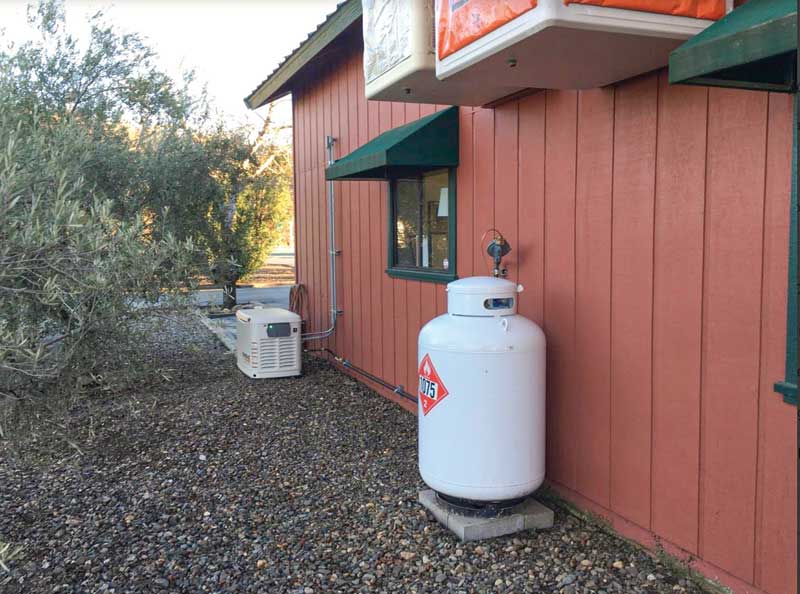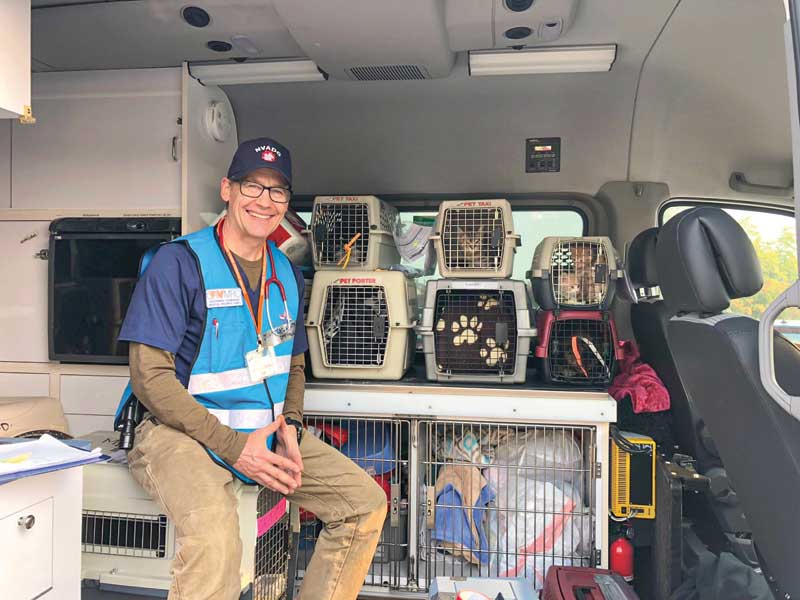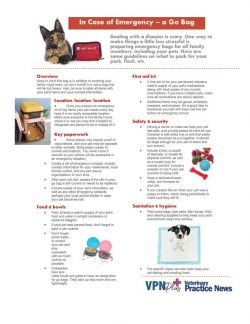
In 2022, more than 100 natural disasters—including severe storms, wildfires, floods, and hurricanes—occurred across the country.1 In the year prior, the U.S. experienced 20 natural disasters, with damage costs of $1 billion or more, and one out of 10 small businesses experienced financial losses due to a natural disaster during the previous 12 months.2
Racelle LaMar, DVM, who practices in Santa Rosa, Calif., experienced a natural disaster in 2017. One October night, Dr. LaMar was awoken at 1 a.m. by a neighbor pounding on her door, telling her family they needed to evacuate immediately.
“The whole horizon was on fire and the winds were blowing 60 to 80 miles per hour,” says LaMar. “We grabbed our dogs and the cat and went to my mother-in-law’s house.”
Fortunately, her family was safe, but her clinic, housed in a 109-year-old farmhouse, burned down.
LaMar’s experience highlights how a natural disaster can put your practice to a halt. The speed and unpredictability of such an occurrence underscore why it is essential to prepare ahead of time with a comprehensive disaster preparedness plan. Stress disaster planning experts at the California Veterinary Medical Association (CVMA) and the Florida Veterinary Medical Association (FVMA) share tips for planning for and navigating a natural disaster.
Creating the plan
Create a personal disaster plan for you and your family, and make sure your staff members have emergency plans for their families as well. The U.S. Department of Homeland Security’s website, Ready.gov, has online tools to help families create one.
“You’re no good to anyone until you know your family’s safe,” says Terry Clekis, DVM, chair of the FVMA’s Disaster Preparedness Committee. “That’s got to be job one.”
After creating a disaster plan for your family, assess your practice’s risk, develop a business disaster plan, and periodically review and update it. Dr. Clekis and Grant Miller, DVM, state coordinator for the California Veterinary Medical Reserve Corps (CVMRC), recommend addressing these questions when formulating your plan:
- How will you get in touch with your staff and make sure everyone’s safe and accounted for?
- Who will be responsible for what?
- How and where will you evacuate animals boarding at your facility?
- How will you contact your clients?
- Do you have a prepared statement ready to post on your website, voicemail, and social media sites to announce a temporary closure or alternate practice location?
- Do you have business relationships with colleagues, local animal shelters, and boarding facilities that could serve as resources during a disaster and that you could help, as well?
- Are back-up copies of records and data stored in the cloud or at an offsite server?
- Do you have an alternate practice site if your building is damaged or destroyed?
- Do you have sufficient supplies to keep practicing in case of supply chain disruptions?
Checking coverage
Talk with your insurance agent and review your property and casualty insurance. Make sure it includes business interruption insurance3 so you can continue to pay your staff and bills until you can reopen your practice. Business interruption coverage enabled LaMar to continue paying her staff while she rebuilt her practice, she says.
It is vital to thoroughly document your equipment and supplies. Video record your entire clinic, recommends Jeff Smith, DVM, who practices in Middletown, Calif., and is a regional disaster coordinator for the CAVMRC.
“Once a year, open every closet and door and film the entire contents of your building so if was destroyed it could be replaced,” says Dr. Smith. Keep receipts for equipment purchases, he adds, because insurance companies will ask for detailed documentation.
Check that your insurance policy covers the cost of rebuilding a facility that conforms with current building codes instead of only what you had before, suggests LaMar.
“I couldn’t rebuild a 1908 farmhouse,” says LaMar. “Earthquake requirements and all of those things have changed, so I was able to rebuild with current codes and replace the same type of spaces that I had previously.”

Upgrading
Upgrade your building to meet recommendations for withstanding the type of natural disaster likely to occur in your area, suggests Smith. For example, if you practice in a region prone to hurricanes, follow recommendations for strengthening your structure against wind damage,4 such as adding storm shutters and hurricane-proof doors.
Similarly, if you are in an area vulnerable to wildfires, follow best practices for reducing the combustibility of your facility such as installing a metal roof and clearing vegetation from around the perimeter of the building.5
If you can afford it, a generator is a wise investment since power may be done for days or even weeks. For instance, when a wildfire knocked out power in the community where Smith practices, his clinic was able to stay open because it had a generator.
Beyond building
In addition to developing a plan for your own family and practice, it is important to prepare for a disaster by forging and strengthening relationships with other veterinary practices, the local animal control department, animal shelters, and boarding facilities. Those connections are crucial for sharing information and resources during a disaster and in the chaotic days that follow.
“Disaster management is a relationship business,” says Clekis. “The time to make a friend is before you need a friend.”
When a natural disaster appears imminent, whether it is a hurricane headed toward land or a wildfire creeping closer to your community, stay informed and follow the advisories, stresses Clekis.
“Pay attention to the information coming in, listen to the news, and watch the weather reports,” he says. “You have to assess your risk. If you have a boarding kennel with 100 animals, you better have a plan for evacuating them.”
In the immediate aftermath of disaster, it usually takes a few days before assistance from governmental agencies and non-governmental organizations is available, he adds, so it is essential to be stocked up on water, batteries, medication, pet food, and other supplies before a disaster hits, so your practice can function during the immediate post-disaster period.
“You really are on your own for the first 24-48 hours,” says Clekis.
If you want to help during a disaster by caring for injured animals or treating pets at an evacuation center, it is important to get training and credentialing ahead of time.
In California, veterinarians can join the volunteer group, CVMRC,6 which is part of a national network of 300,000 volunteer health care professionals trained to assist during a disaster through the Medical Reserve Corps program.7
The CAVMRC was formed in 2009 and has been deployed after every major wildfire in California since then, says Miller. During wildfire emergencies, the volunteer veterinarians, registered veterinary technicians, and veterinary assistants have treated burn injuries and provided routine care to pets in emergency shelters.
The FVMA Disaster Preparedness Committee
is forming its own veterinary medical reserve corps to train veterinarians to assist in a disaster, says Clekis, and is also developing a disaster training track for its annual meeting.
Even though you can’t prevent a hurricane, flood, earthquake, or wildfire from occurring in your community, developing a solid plan it will help you better manage the stress and shock and get your practice back up and running sooner.
“During times of disaster, people’s cognitive abilities fall dramatically,” says Miller. “For that reason, I cannot stress enough the importance of thinking ahead of time to prepare and have a plan and have it ready to go.”

Julie A. Jacob is a communications professional and writer who often contributes to Veterinary Practice News. She lives in Wisconsin with her poodle.
References
- Number of Natural Disasters in the United States in 2022 by Type. Statista.
https://www.statista.com/statistics/216819/natural-disasters-in-the-united-states/ - Furderburk, B. and Misera L. The Impact of Natural Disasters on Small Businesses. Fed Small Business. 15 Nov. 2022. https://www.fedsmallbusiness.org/analysis/2022/the-impact-of-natural-disasters-on-small-businesses
- Orem, T. and Murphy R. What is Business Interruption Service? What It Covers, How to Get It. NerdWallet. 24 Oct. 2022. https://www.nerdwallet.com/article/small-business/business-interruption-insurance
- Metz. J. How to Make Your House Hurricane Proof. Forbes. 27 Oct. 2023. https://www.forbes.com/advisor/homeowners-insurance/hurricane-fortified-home/
- Protect Your Property from Wildfires. FEMA. https://www.fema.gov/sites/default/files/2020-11/fema_protect-your-property_wildfire.pdf
- California Veterinary Medical Reserve Corps. https://cavmrc.net/
- Make a Difference in Your Community. Administration for Strategic Preparedness and Response. https://aspr.hhs.gov/MRC/Pages/index.aspx
